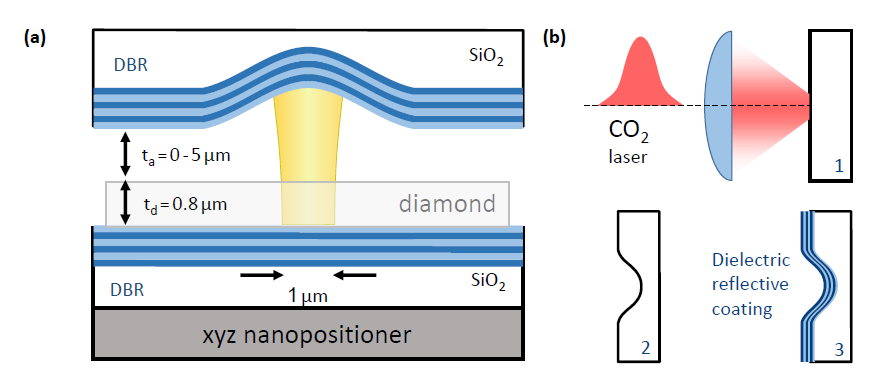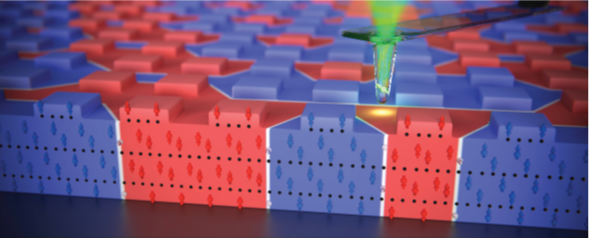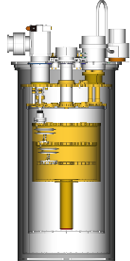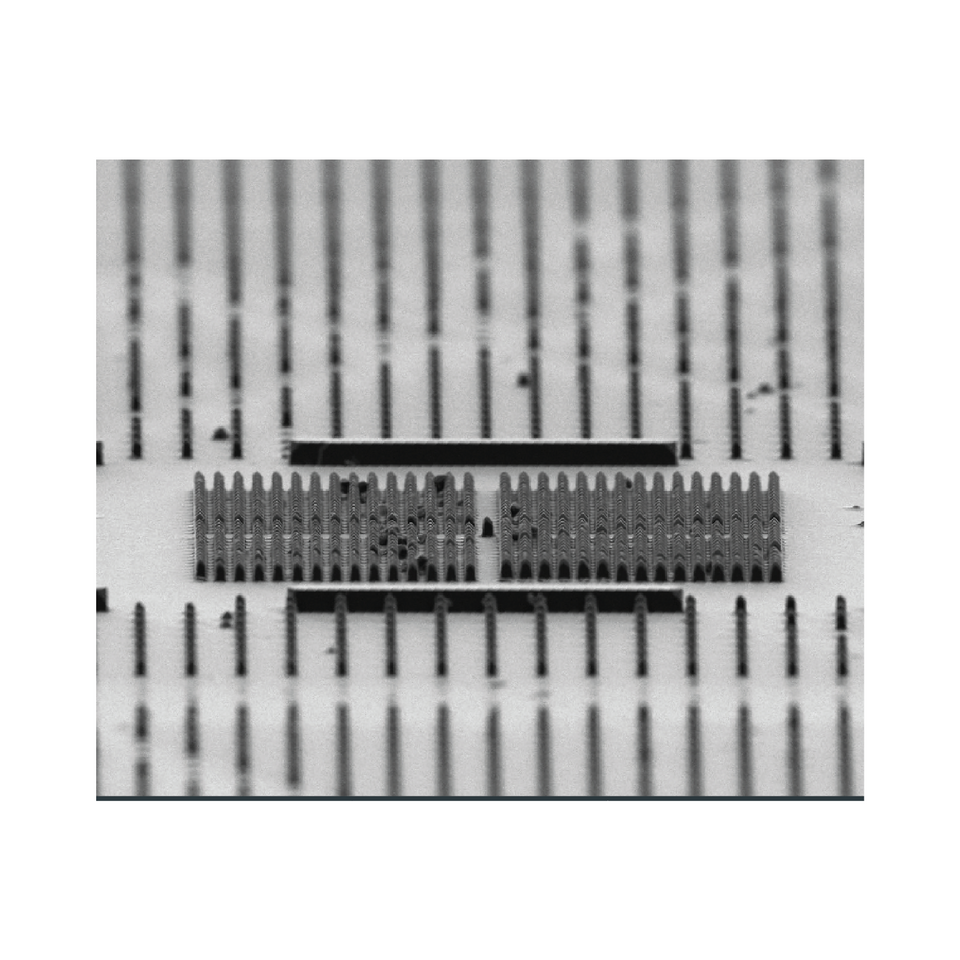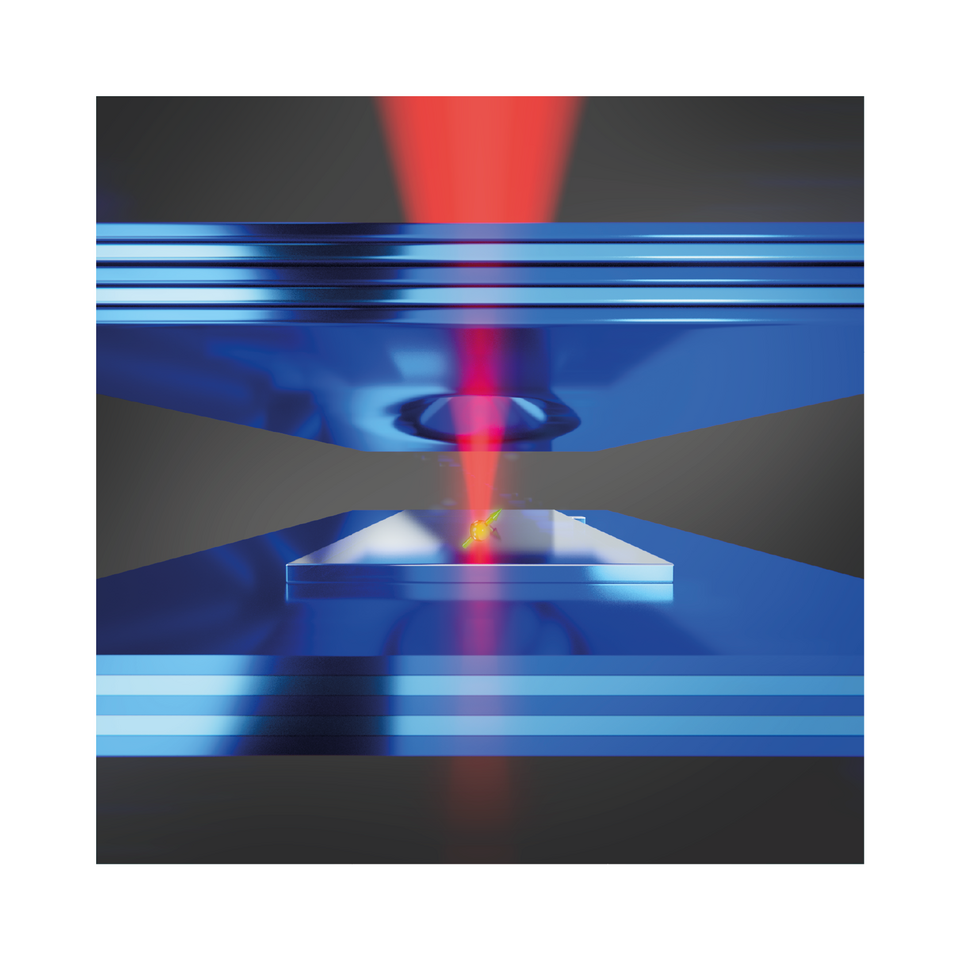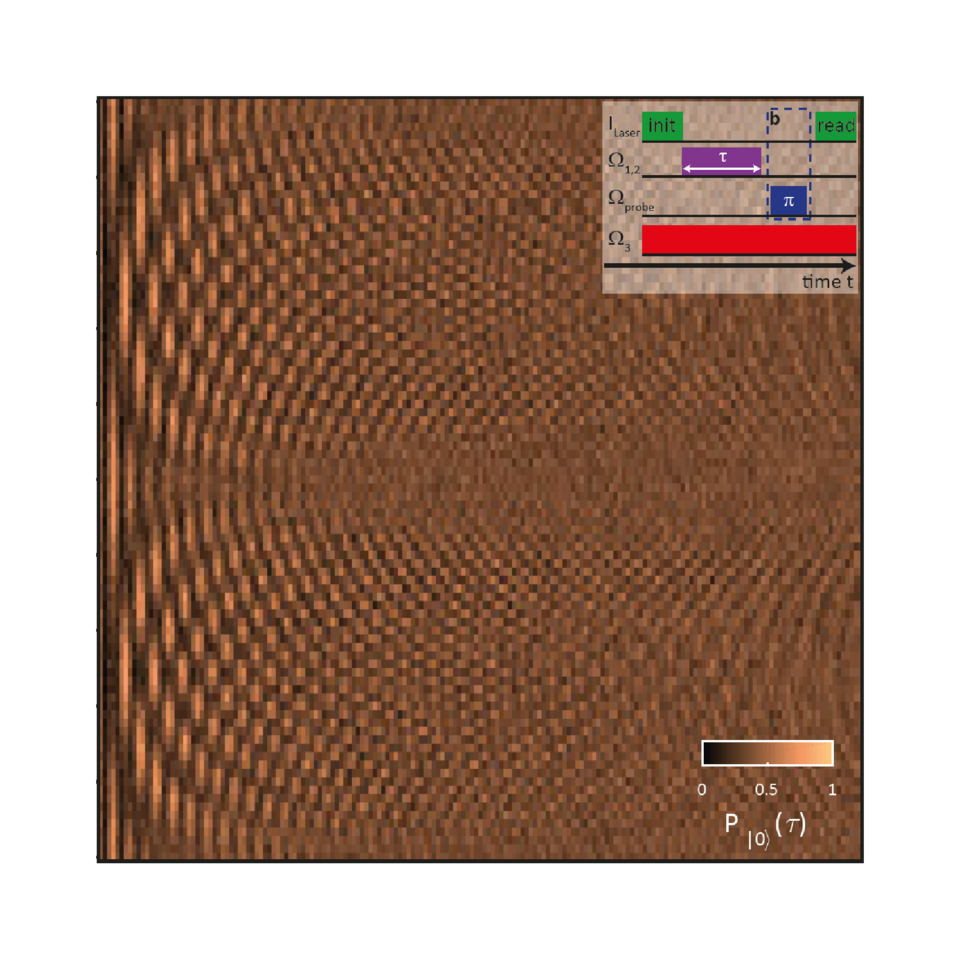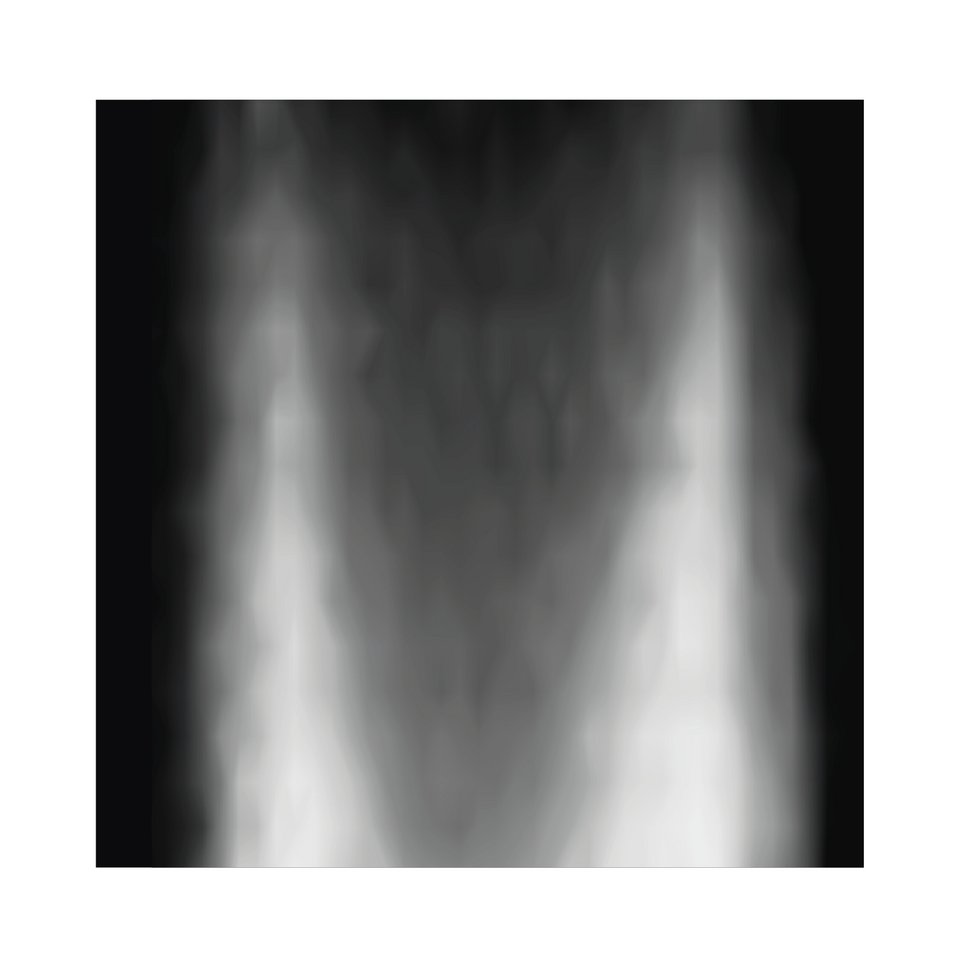PhD Theses
Last updated: Jun 08, 2022
Click on a figure to retrieve the corresponding pdf-file.
2021
Sigurd Somby Flågan
In recent years, tunable Fabry-Perot microcavities have emerged as a compelling platform for enhancing the flux of coherent photons from single colour centres in solid-state hosts. A prominent example of one such colour centre is the nitrogen-vacancy (NV) centre in diamond. The NV centre has a highly coherent, optically addressable electron spin. Furthermore, the NV centre is a source of single photons. Advances in the creation of entangled spin-photon pairs allow for establishing remote spin-spin entanglement – a key building block in a quantum network. However, the scalability past a few network nodes is limited by modest entanglement rates, in turn limited by the detection efficiency of coherent photons. Limiting factors include the long radiative lifetime and the small branching ratio of “useful” photons into the zero-phonon line (ZPL). However, neither the radiative lifetime nor the branching ratio are rigid features of the NV centre – the flux of ZPL photons can be greatly accelerated in a resonant microcavity.
This thesis reports on the realisation of a high-quality tunable Fabry-Perot microcavity embedded with a diamond membrane. However, the diamond alters the cavity performance, rendering the cavity sensitive to surface related losses. Despite operating in a geometry where the standing wave inside the cavity possesses an anti-node at the diamond surface, quality (Q) factors exceeding 100000 were realised. The benefit of this geometry is the strong confinement of the vacuum electric-field to the diamond – the current cavity design allows for the realisation of Purcell factors exceeding 300, thus increasing the fraction of photons emitted into the ZPL from 3% to 89%.
The versatile design of the microcavity was demonstrated further by enhancing the Raman transition from the single crystalline diamond. Compared to free-space measurements under likewise identical conditions, a 59-fold intensity enhancement was demonstrated. This enhancement factor encompasses the Purcell effect and the improved detection efficiency provided by the cavity. The Raman transition couples to all cavity modes, allowing for in situ optimising and benchmarking the cavity performance. Additionally, it facilitates coupling to the external single-mode detection optics. Further enhancement of the Raman intensity can be achieved by establishing a double resonant condition, with both the pump laser and the Raman transition being resonant. Resonant recirculation of the pump laser increases the power density inside the cavity, providing a platform with prospects of realising a Raman laser with sub-mW threshold pump power. Exploiting a small thickness gradient in the diamond enabled continuous tuning of the double resonance condition across a spectral window of ∼1THz. The tuning range is only limited by the travel range of the piezo – with an adequate travel range, continuous tuning is, at least in principle, possible across the entire reflective stopband.
As computing requirements and data volumes continue to increase, the need for faster, more efficient memories has become a driving force in many research areas. One proposed alternative to current ferromagnetic (FM) storage technology is antiferromagnetic (AFM) memories, which promise faster, more energy-efficient switching and higher bit densities. Developing such technologies requires progress on two fronts. On the one hand, we must understand and harness the AFM magnetic textures central to the proposed memory devices. At the same time, we require technologies capable of addressing these typically hard-to-access systems. In this thesis, we use magnetometry based on the nitrogen vacancy (NV) center in diamond to address both sides of this problem.
NV magnetometry, in particular scanning magnetometry, can be employed in a variety of environmental conditions, providing access to a wide range of materials and phenomena. Furthermore, the high magnetic field sensitivity and spatial resolution achievable with this technique enable us to address the nanoscale magnetic textures of interest. However, sensitivity and resolution are limited by our ability to collect the NV center photoluminescence (PL) and by how close we can bring the NV to the magnetic field source, respectively. Here, we aim to improve on the state-of-the-art scanning NV magnetometry probe with a novel design based on a truncated parabolic pillar. The parabolic nature of the pillar leads to excellent directional emission of the PL, allowing us to demonstrate median PL rates of 2.1 MHz and collection efficiencies of 57%. As such, we realize improved sensitivities compared to the state-of-the art scanning probes while simultaneously achieving nanoscale resolution through the truncated end facet of the pillar.
We then use these improved scanning probes to study the magnetic properties of a magnetoelectric AFM: chromia. Due to its room-temperature AFM ordering and the ability to switch the magnetic order with electric fields, this material is a popular candidate for spintronics applications. In our study, we demonstrate control over the magnetic orientation of a bulk chromia (Cr2O3) crystal and employ its magnetoelectric properties to nucleate domain walls (DWs). Using NV magnetometry, we characterize the surface magnetization of Cr2O3 and investigate the DW structure. We furthermore demonstrate an interaction between the DW and patterned surface topography, allowing us to develop a model of the DW mechanics. In particular, we observe a Snell's law-like behavior of the DW in the presence of topographical steps and pinning of the DW to the edges of these steps. We use this pinning, together with local heating of the Cr2O3 crystal, to exert control over the motion of the DW.
These results bring us one step closer to achieving AFM-based memories. Having shown the ability to generate, control, and move DWs in an AFM crystal, we have laid the groundwork for a DW-based memory. Moreover, by improving the understanding of antiferromagnetic DW mechanics, we highlight material properties of Cr2O3 that may benefit and guide future material research.
2020
Emerging quantum technologies, such as quantum information processing and quantum metrology, require quantum systems that provide reliable toolsets for initialization, readout, and coherent manipulation as well as long coherence times. The coherence of these systems, however, is usually limited by uncontrolled interactions with the surrounding environment. In particular, innovations building on solid-state spin systems like the Nitrogen-Vacancy (NV) center in diamond ordinarily involve the use of magnetic field-sensitive states. In this case, ambient magnetic field fluctuations constitute a serious impediment that shortens the coherence time considerably. Thus, the protection of individual quantum systems from environmental perturbations constitutes a fundamentally important but also a challenging task for the further development of quantum appliances.
In this thesis, we address this challenge by extending the widely used approach of dynamical decoupling to protect a quantum system from decoherence. Specifically, we study three-level dressed states that emerge under continuous, `closed-contour' interaction driving. To implement and investigate these dressed states, we exploit well-established methods for coherent microwave and strain manipulation of the NV center spin in a hybrid spin-mechanical system. Our results reveal that this novel continuous decoupling mechanism can overcome external magnetic fluctuations in a robust way. We demonstrate experimentally that the dressed states we created are long-lived and find coherence times nearly two orders of magnitude longer than the inhomogeneous dephasing time of the NV spin, even for moderate driving strengths.
To realize direct and efficient access to the coherence-protected dressed states under closed-contour driving, we further demonstrate the use of state transfer protocols for their initialization and readout. In addition to an adiabatic approach, we apply recently developed protocols based on `shortcuts to adiabaticity' to accomplish the initialization process, which ultimately accelerates the transfer speed by a factor of 2.6 compared to the fastest adiabatic protocol with similar fidelity. Moreover, we show bidirectionality of the accelerated state transfer, which allows us to directly read out the dressed state population and to quantify the transfer fidelity of ≈99%.
By employing the methods to prepare and read out the dressed states, we lay the foundation to meet the remaining key requirement for quantum systems -- coherent quantum control. We present direct, coherent manipulation of the dressed states in their own manifold and exploit this for extensive characterization of the dressed states' properties. Thus, our results constitute an elementary step to establish the dressed states as a powerful resource in prospective quantum sensing applications.
Harnessing quantum systems like the dressed states as nanoscale sensors of external fields requires the detailed characterization of the local internal environment. In the final part of this thesis, we report on the determination of intrinsic effective fields of individual NV center spins. We study single NVs in high purity diamond and find that local strain dominates over local electric fields. In addition, we experimentally demonstrate and theoretically describe a new technique for performing single spin-based polarization analysis of microwave fields in a tunable, linear basis.
The liquefaction of helium and the dilution refrigerator have enabled cooling down objects to 4K and even mK temperatures. Fascinating effects, such as superconductivity and strongly correlated electron systems (SCES) emerge at these temperatures and can be studied in appropriate cryogenics experiments. A powerful tool to study magnetic phenomena in such systems is a point lattice defect in diamond, the nitrogen-vacancy (NV) center. The NV center contains an electron spin that offers exceptional properties in terms of coherence time and optical addressability, and can thereby be employed for high-performance magnetic field sensing. Due to its atom-like size, the NV center can be used for nanoscale magnetometry, particularly in a scanning probe configuration where a single NV is located in a tip. This allows for nanometric spatial resolution combined with sensitivities of approximately 1 µT/Hz^0.5. In this work, we pave the way towards NV magnetometry at mK temperature by implementing NV magnetometry in a dilution refrigerator, so far at 4 K, and by conducting transport experiments on a SCES at mK temperature.
At first, two phenomena in the type-II superconductor YBCO are examined at 4K in a liquid helium bath cryostat. On the one hand, the Meissner effect is measured over a thin YBCO disk by directly imaging the penetration of magnetic fields into the superconductor. On the other hand, stray magnetic fields emerging from vortices in the same superconductor are imaged with approximately 30nm resolution. In both cases, we benchmark our findings against existing theoretical models and use this analysis to extract quantitative values for the London penetration depth.
Additionally, we examine out-of-plane (OOP)-oriented NV centers with respect to the scanning plane, which offer benefits such as improved sensitivity and data interpretability. OOP-oriented NV centers in our fabricated scanning probes are uniquely identified and used for nanoscale magnetic imaging for the first time.
The oxide interface LAO/STO, which hosts a two-dimensional electron gas that exhibits SCES physics, is examined in the dilution refrigerator. Transport measurements show signs of superconductivity and laser illumination is found to significantly increase the conductance. In terms of NV magnetometry in a dilution refrigerator at 4 K, current imaging reveals an inhomogeneous current flow through the interface. In contrast to previous findings, no magnetic signatures are found.
Lastly, longitudinal T1 relaxation is studied in a high-density NV ensemble. Relaxation rates at mK are found to be lower than at 4 K, on the order of 1 Hz. However, they are still much higher than in previous findings, possibly explainable by spin diffusion out of the laser focus. At mK temperature, a shift of the thermal spin population is observed, corresponding to the Boltzmann distribution.
Overall, in this thesis we can present meaningful results in several areas, some of which have already been published. In the future, we will use the increased sensitivity of OOP-oriented NV magnetometers and explore magnetism and superconductivity in various exotic materials at mK temperatures.
2019
Moore's Law demands for innovation not only to solve the question of how to store even more information on even smaller areas but also in how to access this information. Both problems make point defects in solid-state systems very interesting. Color centers in diamond are one of these atom-like systems. Their electronic spins can be used as a versatile sensor or quantum storage. These sensors live up to their full potential when combined with a scanning technique as atomic force microscopy (AFM). The precise control of the position combined with an atom-sized light source or sensor opens up various possibilities. The main struggles encountered by the field so far are the difficulty of retaining the crystal quality of bulk diamond and simultaneously have a sharp tip to get the best topological feedback possible. In our work, we present three different avenues to tackle this. We conduct a study of the cause of decoherence in plasma etched nanostructures and test different treatments to reduce the effect. We test a novel method to stabilize an alternative color center believed to be less sensitive to electric field noise. Furthermore, we explore a new approach combining top-down fabrication and bottom-up overgrowth to get sharp tips with good crystal quality. The combination of the individual avenues has the potential to bring the sensing and imaging capabilities of color center-based sensing to the next level.
Individual electronic spins can yield close-to-ideal magnetometers to investigate magnetic phenomena on the nanoscale. Spins offer sensitivity to magnetic fields by virtue of the Zeeman effect and can be localized to atomic length scales, which enables nanoscale resolution in imaging. The electronic spin of the Nitrogen-Vacancy (NV) center in diamond has been identified as a particularly fruitful system to implement these concepts, as its additional ability of optical spin initialization and readout renders the NV center a non-invasive and quantitative magnetometer with single-spin sensitivity and nanoscale spatial resolution. Nitrogen-Vacancy based magnetometry has been widely exploited exclusively under ambient conditions. Advancing the frontiers of nanoscience at low temperature, however, hinges on the availability of novel sensors for nanoscale imaging such as the Nitrogen-Vacancy center.To fill this gap, in this thesis we developed and employed an NV-based scanning magnetometer at cryogenic temperatures. We present the implementation of an atomic force microscope, which is functionalized with a single NV center, situated in a liquid helium bath cryostat, and interfaced with a confocal microscope for optical initialization and readout of the NV's electronic spin. We demonstrate DC magnetic field sensitivities better than uT/sqrt(Hz) and an unprecedented spatial resolution of 30 nm. Moreover, we introduce powerful post-processing techniques and employ them on the recorded quantitative magnetic stray field maps. This allows for the retrieval of important material parameters by recovering the underlying planar current distribution or spin texture.Our results illustrate the power of NV magnetometry in exploring local magnetic properties of electronic systems with high resolution, and the great potential for future nanoscale explorations of a large range of complex, condensed matter systems at cryogenic temperatures.
2017
The nitrogen-vacancy (NV) center in diamond has an optically addressable, highly coherent spin. However, an NV center even in high quality single-crystalline material is a very poor source of single photons: extraction out of the high-index diamond is inefficient, the emission of coherent photons represents just a few per cent of the total emission, and the decay time is large. In principle, all three problems can be addressed with a resonant microcavity, which significantly boosts the emission rate of coherent photons into the cavity mode based on the Purcell effect. In practice though, it has proved difficult to implement this concept: photonic engineering hinges on nano-fabrication yet it is notoriously difficult to process diamond without degrading the NV centers. In this thesis, we present a microcavity scheme which employs minimally processed diamond membranes, thereby preserving the high quality of the starting material. The miniaturized plano-concave Fabry-Perot microcavity platform features full in situ spatial and spectral tunability. We demonstrate a clear change in the lifetime for multiple individual NV centers on tuning both the cavity frequency and anti-node position. The overall Purcell factor for the zero-phonon line (ZPL) of FPZPL ~ 30 translates to an increase in theZPL emission probability from ~ 3% to ~ 46 %. Furthermore, we report the creation of a low-loss, broadband optical antenna giving highly directed output from a coherent single spin in the solid state. The device, the first crystalline solid-state realization of a dielectric antenna, is engineered for individual NV electronic spins in diamond. The photonic structure preserves the high spin coherence of single-crystalline diamond (T2 ≥ 100 μs). We demonstrate a directionality of close to 10 and single photon count rates approaching one MHz. The analysis of the angular emission pattern of our device suggests that 95% of the broadband NV fluorescence is channeled into a solid angle corresponding to a numerical aperture of 0.8. The abovementioned approaches feature complementary benefits. The narrowband enhancement of the ZPL emission rate provided by the microcavity benefits applications in quantum information processing relying on coherent photons. With the prospect of integrating lifetime-limited emitters and achieving a high ZPL collection efficiency our results pave the way for much enhanced spin-photon and spin-spin entanglement rates. On the other hand, by channeling the major fraction of the broadband NV fluorescence into a narrow solid angle the dielectric optical antenna facilitates efficient spin readout. Our approach enables a near-unity collection efficiency which, upon mitigation of the known photon losses, renders it a potential key technology for quantum sensing applications.
Scanning nanomagnetometry based on the electronic spin of the nitrogen vacancy (NV) center in diamond is an emerging sensing technology, which allows for the probing of magnetic fields on the nanoscale. High sensitivity, of a few tens of nT$/\sqrt{\rm{Hz}}$, can be achieved by exploiting the extraordinary properties of this special lattice defect. Incorporating this atomic sized sensor in the apex of all-diamond scanning probes allows controlled proximity of the NV center and a sample to be achieved. The resulting resolution of a few tens of nm in combination with an NV's sensitivity offers unique possibilities for exploring new physical properties or phenomena.
In this thesis, we developed and characterized a high performance scanning NV magnetometer and we demonstrate its potential for probing magnetic fields in two applications. We implemented a procedure to fabricate single-crystal, all-diamond scanning probes and developed a highly efficient and robust approach for integrating these devices into our setup.
The resulting sensitivities of$\eta_{\rm{DC}}\sim750\,$nT$/\sqrt{\rm{Hz}}$ for DC and$\eta_{\rm{AC}}\sim114\,$nT$/\sqrt{\rm{Hz}}$ for AC-magnetic fields and resolution of$50\pm32\,$nm enabled real space imaging of the stray field of an antiferromagnet and the imaging of microwave magnetic fields with unprecedented spatial resolution. Both applications illustrate the potential of this powerful technique for imaging weak magnetic fields and revealing physical properties that are inaccessible with alternative approaches. Scanning NV magnetometry therefore forms an attractive, new technique, which will have a profound impact on many different research areas ranging from magnetism and advanced material sciences to spintronics and quantum computing.
Hybrid spin-oscillator systems, formed by single spins coupled to mechanical oscillators, have attracted ever-increasing attention over the past few years, triggered largely by the prospect of employing such devices as high-performance nanoscale sensors or transducers in multi-qubit networks. Provided the spin-oscillator coupling is strong and robust, such systems can even serve as test-beds for studying macroscopic objects in the quantum regime. In this thesis we present a novel hybrid spin-oscillator system that consists of a diamond cantilever whose mechanical motion couples to the spin degree of freedom of embedded NV centers through crystal strain. This thesis starts with a characterization of the coupling strength between NV spin and resonator motion. Static cantilever bending experiments reveal spin-strain coupling constants of several GHz per unit of strain, corresponding to a single phonon coupling strength g0 ≈ Hz. Although we demonstrate that our hybrid system resides deep in the resolved sideband regime, our current experimental conditions prevent bringing the diamond resonator to its motional ground state, since spin decoherence rate and mechanical heating rate exceed g0 by several orders of magnitude. However, cooling the resonator, even to its motional ground state, is possible if cantilever dimensions are reduced to the nanometer scale and corresponding experiments are performed at cryogenic temperatures. While spin-strain coupling is not favorable for such experiments in the quantum regime, it offers many other exciting features. In the second part of this thesis, we report on the implementation of a novel continuous decoupling scheme that protects the NV spin from environmental noise, increasing both Rabi oscillation decay time and inhomogeneous coherence time by two orders of magnitude. The remarkable coherence protection is explained by the robust, drift-free strain-coupling mechanism and the narrow linewidth of the high-quality diamond mechanical oscillators. A major finding of this thesis is the demonstration of coherent spin manipulation with transverse AC strain fields, which is presented in the third part of this thesis. We show that AC strain driving not only addresses a magnetic dipole forbidden transition, but also allows working in the strong driving regime, in which the induced spin rotation frequency exceeds the initial spin splitting. Few systems have reached this regime, despite the appeal of studying dynamics beyond the rotating wave approximation. Additionally, continuous strain driving enhances the NVs spin coherence time by decoupling it from environmental magnetic noise. In the last part of this thesis, we combine coherent MW and strain spin driving to realize a three-level ∇-system in the NV ground state by coherently addressing all three spin transitions. Our studies of the spin dynamics not only confirm the theoretical prediction that the global phase (i.e. the relative phase of the three driving fields) governs the occurring spin dynamics, but also that closed-contour driving shields the NV's spin from environmental noise without applying complicated decoupling schemes. The corresponding decoupling mechanism is well explained by the effect of noise on the ∇-system Hamiltonian. Based on our findings, we believe our closed-contour interaction scheme will have future applications in sensing and quantum information processing, for example as a phase sensor or as a test-bed for state transfer protocols.
The present thesis is devoted an all-optical study of the physical properties of the mesoscopic ensemble of nuclear spins contained in an individual, self-assembled quantum dot (QD). QDs are artificial entities that allow for the trapping of individual charge carriers in all three spatial dimensions. The trapping length scales are thereby small enough to require a quantum mechanical treatment of the QD chargecarrier confinement. The QDs studied here are self-assembled InAs nano-crystals which contain roughly 105 nuclei, all of nonzero nuclear spin. The nuclear spins can be manipulated and measured by using the spin of a trapped QD electron as an agent which couples to the nuclei via the hyperfine interaction. Electron spins can be optically oriented due to selection rules of optical interband transitions in the QD semiconductor material. This electron spin orientation is then transferred to the nuclear spins via the hyperfine interaction, leading to a dynamical nuclear spinpolarization (DNSP). At the same time, the hyperfine interaction causes a shift of the energy of the electron in contact with spin polarized nuclei. This fact is exploited here to measure the degree of DNSP through the corresponding spectral features in the light which is emitted upon recombination of the optically generated QD electrons.This thesis starts with a description of the steady state behavior of optically generated DNSP. It is shown that the transfer of spin information between the electron and the nuclei depends strongly on the degree of the nuclear spin polarization itself.The corresponding feedback of DNSP on the electrons takes the form of an effective magnetic field which can be on the order of a few Tesla and renders the coupled electron-nuclear spin system highly nonlinear. In particular, experimental evidence for a hysteretic behavior of the coupled electron-nuclear spin system in an external magnetic field is presented and explained with a classical rate equation model.The focus of the second part of the thesis lies on the dynamics of DNSP which isstudied using a time-resolved photoluminescence technique. In addition to measuring the timescales for buildup and decay, this experiment revealed an unexpected aspect of the dynamics of DNSP: while an optically pumped electron spin can be used to polarize the nuclear spins, the electron can also be very efficient in destroying an established DNSP in the absence of optical excitation. In this case, the electron spin is randomly fluctuating, thereby causing relaxation of the nuclear spins. This electron mediated decay of DNSP is discussed in detail as a function of the electron spin correlation time and of external magnetic fields. If the electron spin fluctuations become too fast, the lifetime of DNSP can increase again due to an effect called motional narrowing which is observed experimentally. Furthermore, the nonlinear behavior of DNSP in the presence of external magnetic fields leads to the observation of DNSP decay curves which are highly non-exponential. The presented results give new insights into the dynamics of nuclear spins in semiconductor QDs and show possibilities of manipulating the QD nuclear spin ensemble. The results of this thesis could enable a tailoring of the properties of the nuclear spin system with the aim to prolong the coherence time of the QD electron spin. In self-assembled QDs, this time is limited by the slow fluctuations of the nuclear magnetic field which happen on the same timescale as the decay of DNSP which was determined in this work.

